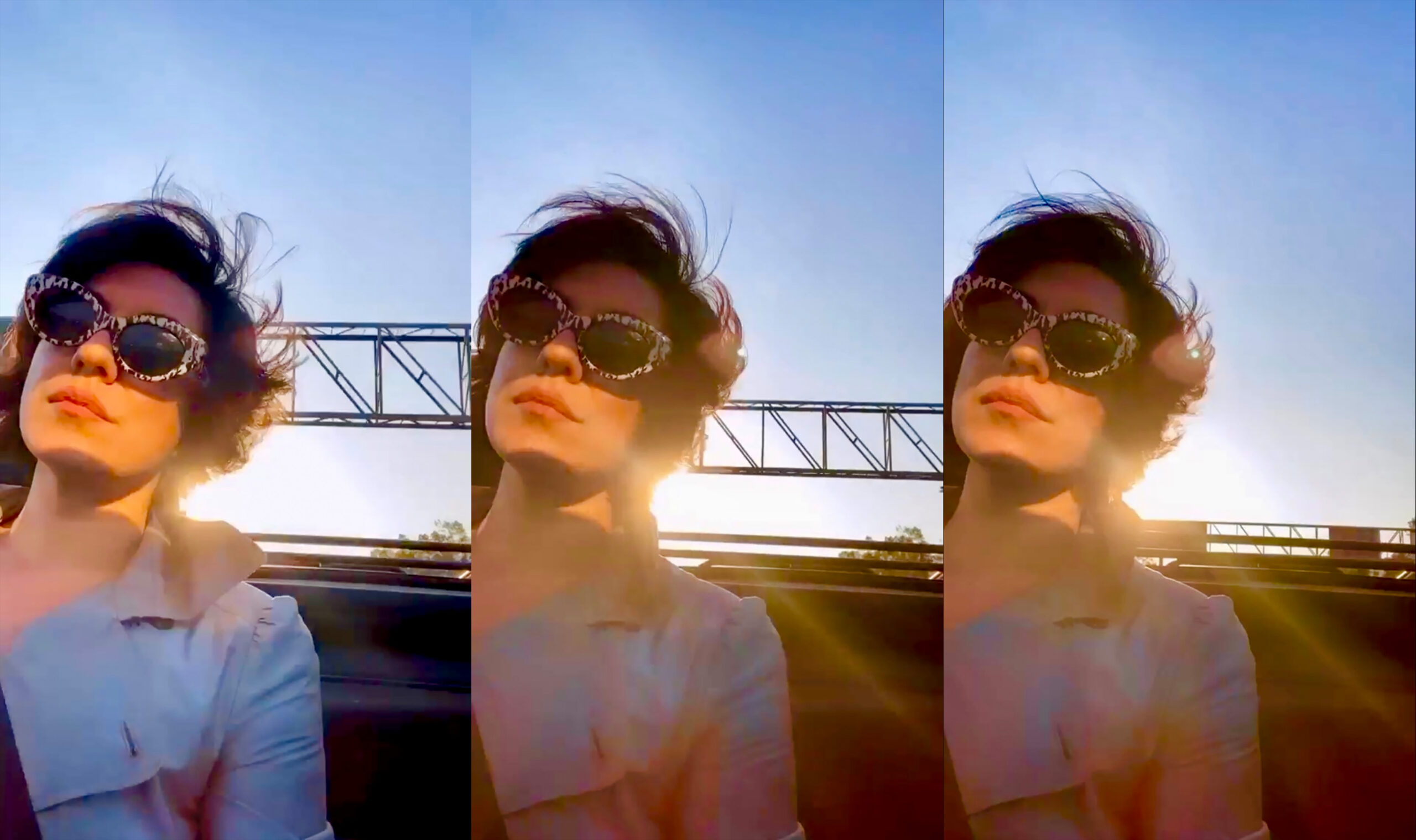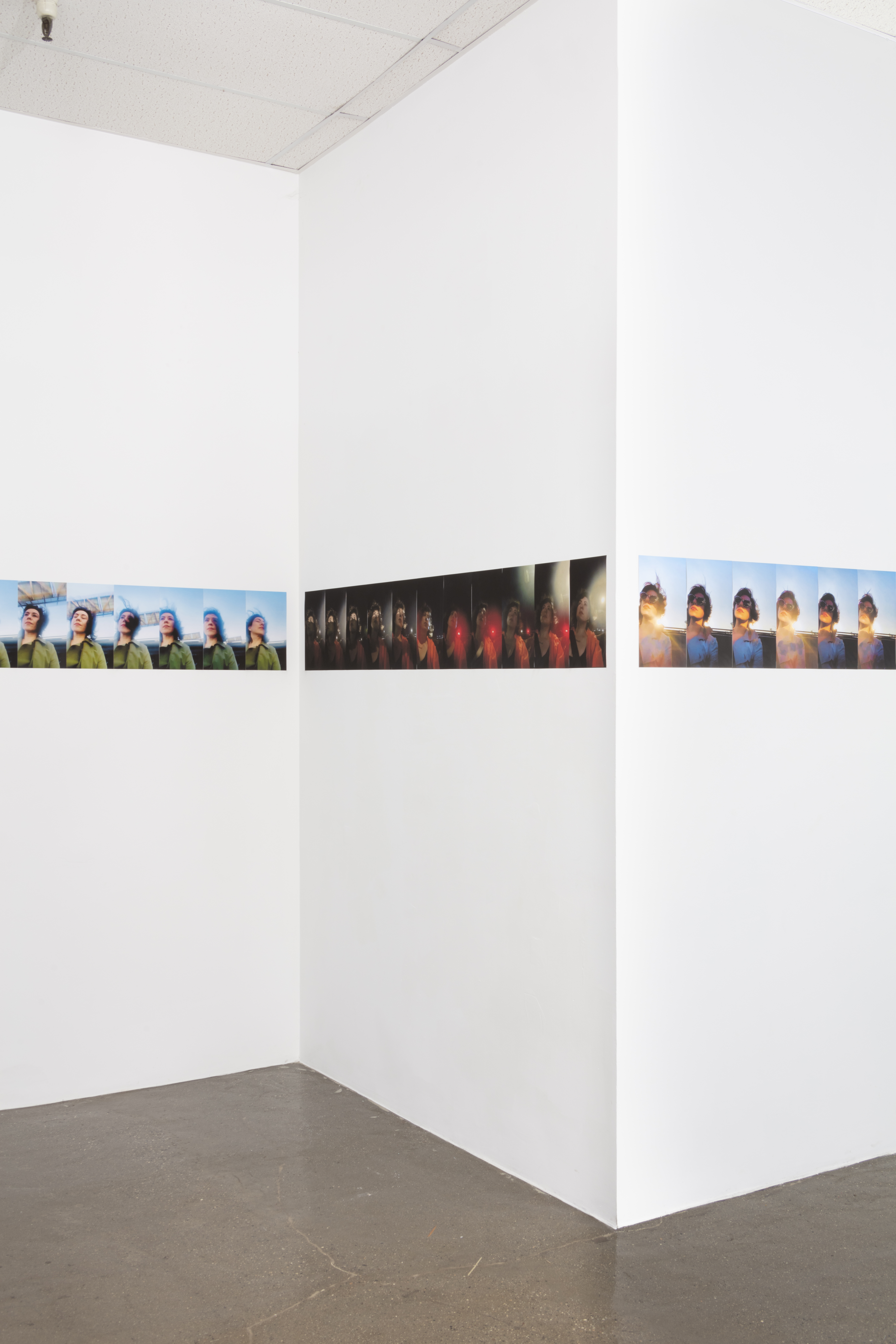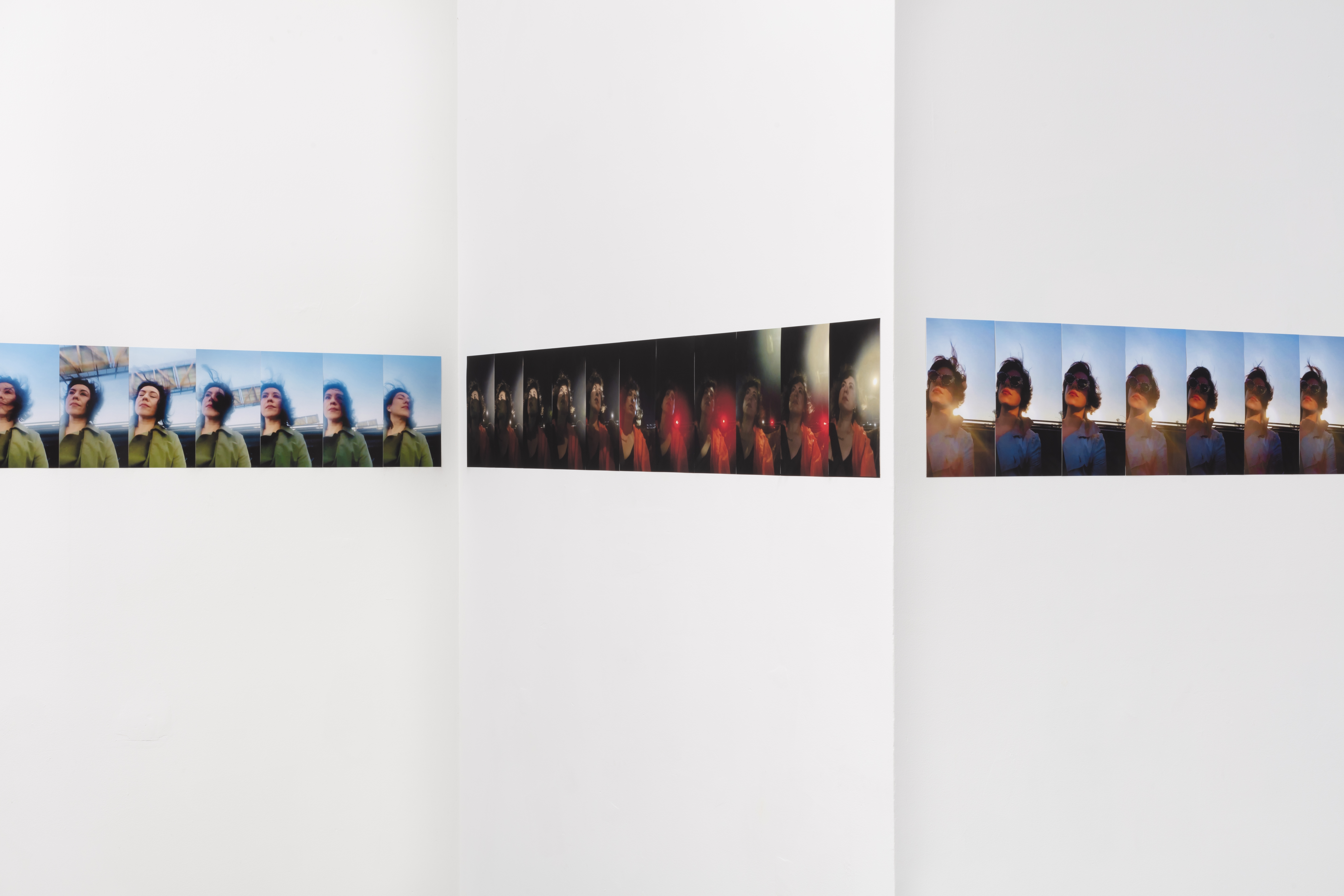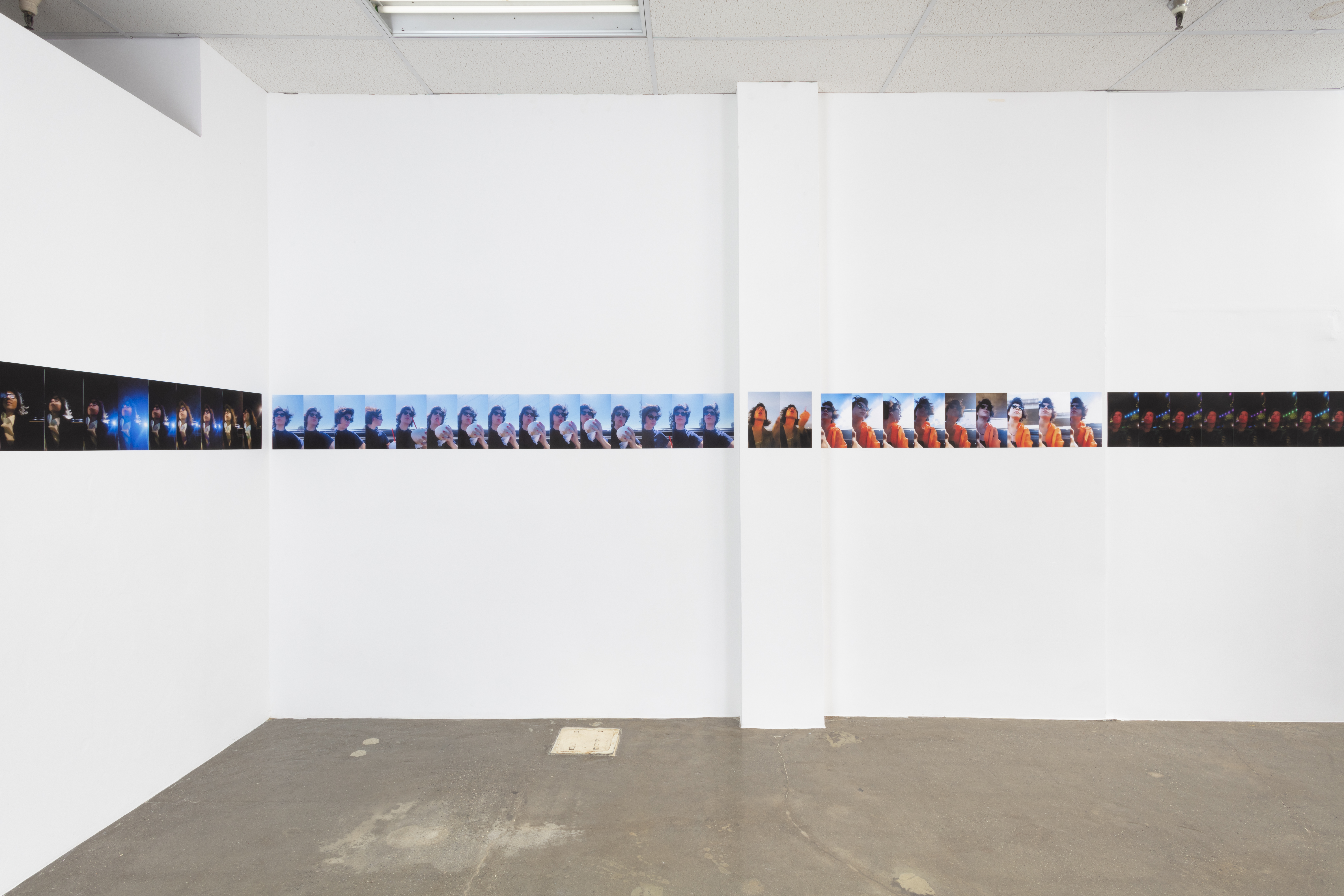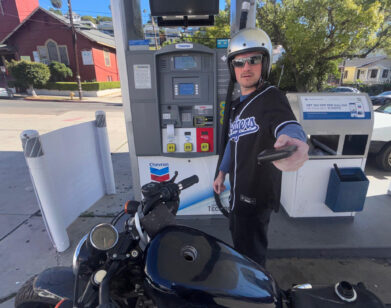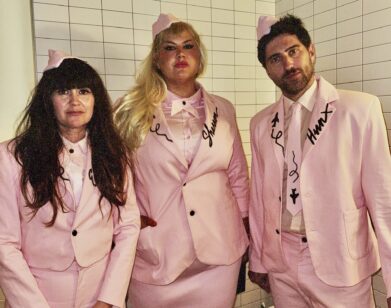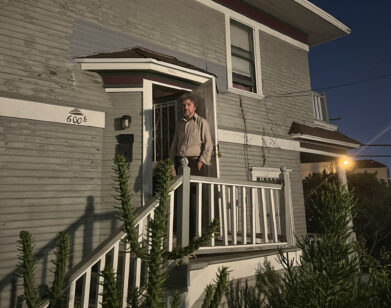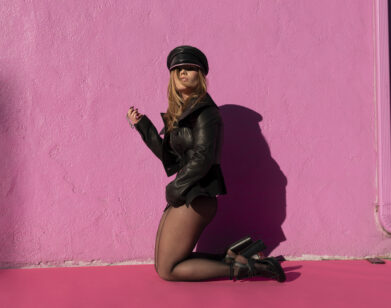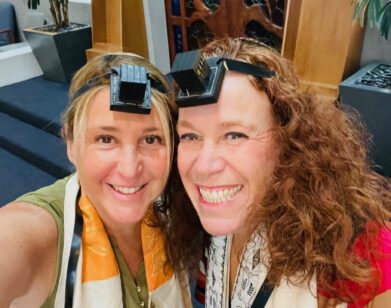VROOM
Christina Catherine Martinez Risks It All For the Perfect Driving Selfie
The first time I watched Christina Catherine Martinez perform, she burst onstage with shrimp cocktail sunglasses over her eyes and a McDonald’s cheeseburger stuffed into her panties. By her act’s ketchup-splattered climax, Martinez had us reflecting on neoliberalism, art theory, and the very nature of comedy itself. She also made out with a random guy from the audience.
In our age of online exhibitionism, private lives and public personas grow murkier with each passing post. This month, Martinez celebrates the allure of performance in Eleanor, her thrilling series of self-portraits featuring the artist behind the wheel of her iconic red Mazda Miata. Opening this week at enfant terrible gallery No Moon, Eleanor captures the spirit of Martinez’s eclectic artistic practice. Mixing writing, stand up, photography, filmmaking, and general clownery, Martinez muddies the boundaries between documentary and fiction, trash and art, reality and fantasy.
There’s a risqué, car crash spectacle to Martinez’s work, and especially so with Eleanor—the photos are raw, kinky and confrontational, impossible to look away from. In anticipation of her first US solo show, Martinez and I got on a call to talk boyfriends, the surreal glamor of L.A. strip malls and, naturally, SoCal’s sexiest drives.
———
CHRISTINA CATHERINE MARTINEZ: Hello?
SAMMY LOREN: Hi, Christina. What’s up?
MARTINEZ: It’s a bit gross and gray and Londonish in L.A., so I’m wearing my rom-com sweater. I’m trying to get my Nora Ephron on. How big can this sweater get?
LOREN: That’s perfect. And I’m hiding out inside some chic little members-only club that I just stormed into to use the wifi.
MARTINEZ: Did you just walk in?
LOREN: Yeah. I just was like, let’s just do it.
MARTINEZ: No way. I did this same thing in New York. I was caught in the rain on the upper one of the sides, and I ducked into the French Embassy to charge my phone and get out of the rain. I think if you wear nice shoes and you speak a little French, you can just hang out anywhere you want.
LOREN: Exactly. Congrats on the show. Obviously, I’m a fan. Tell me about the origins of your first solo show at No Moon Gallery, Eleanor.
MARTINEZ: It’s such a long backstory. Eleanor is the name of my car and she’s a 1997 Mazda Miata. Cherry red, pop-up headlights, et cetera. She was actually a gift from an ex-boyfriend. When I got the Warhol grant in 2019, he knew that a Miata had always been my dream car, which is kind of a modest dream car, to be honest. He was like, “You should buy yourself a Miata. Andy Warhol would’ve wanted it.” And I was like, “I can’t afford to just buy a car for fun,” so he was like, “I’ll get it for you.”
LOREN: Nice boyfriend.
MARTINEZ: Nice boyfriend. But driving in a convertible is really fun, I’d never had a car like that before. It’s rickety and in the open air and you just feel more present than in newer cars, which are kind of hermetically sealed and climate controlled. But in 2020 during lockdown, I was doing these long drives at night or during the day. I’d opened Instagram and the camera came up and I happened to see myself in the Stories function. I thought that looked neat, so I just recorded myself driving through the streets that night in my car. There was really no intention behind it, it just became a ritual. After a while, people started responding to it. I’d get messages saying, “I could watch these for hours.” I thought, if this thing has any artistic merit whatsoever, it’s that it wasn’t meant to be an art project. All of the videos were very spontaneous. I was being filmed for a documentary and at one point the director was like, “We need to get some B roll of you driving around in your car,” and I was like, “I got you, fam.”
LOREN: You were like, “Oh, I already have all this footage.”
MARTINEZ: And when I showed him the footage, he was blown away. He’s like, “You’ve already been making a documentary for two years.” That kind of changed my perception of them because I didn’t necessarily think of them that way. But to be honest, the documentary process was so intense and emotionally draining that once we were done. I just stopped doing them for a while because I was just fucking sick of filming myself.
LOREN: How did you connect with No Moon? Because that’s the major pivot.
MARTINEZ: I had interviewed Peter [Tomka] about his space for a separate article I was writing about art and astrology, and we just got into a whole side conversation about photography and film. Then in late September, Peter texted me out of the blue and asked if I was working on anything photo-based, and I said, “Well, there’s these hundreds and hundreds of videos that I have, maybe we can do something with that.” What’s interesting is I’ve been waiting for an end point for this thing to come, and as soon as Peter and I had that conversation, I knew it was over. It was almost like the project became too self-aware.
LOREN: As a project, Eleanor is so L.A. to me. It’s unconventional, it’s kind of risky. You’re driving around, maybe you’re going to crash your car just to get a fucking selfie. It kind of has this lowbrow celebrity texture to it. Even the gallery is an artist-run space and it’s a roaming gallery that never has a real home. Why do you think L.A. cultivates these types of projects and places? I don’t feel like this show could happen anywhere else.
MARTINEZ: No. It’s hard to say because I am a native Angeleno, so I have the freedom of not having to conform to the image of L.A. that people have because whatever I do is L.A. Yet this thing as this thing happened so organically, it became so L.A. There’s me driving in the convertible and there’s palm trees and weird and iconic L.A. imagery in the background. I’m apt to say it has more to do with the art and culture industry writ large, where high and low and rich and poor rub up against each other a lot.
LOREN: Yeah. Also, driving is so essential to L.A. life. I hate driving and I don’t have a car, but I’m always driving. It’s such a source of frustration, but it’s also a source of pleasure.
MARTINEZ: And as a working class East L.A. woman, cars are also a source of a lot of consternation, breaking down and this and that, and the Miata is the first car I’ve that is truly a pleasure to drive. Since 2020 I’ve been performing a lot, so a lot of the videos are either on my way to or coming home from shows or auditions. And as I was going through all of these videos, I kind of remembered what I was doing at the time or where I was coming from, and I looked so happy. I see them as these documentation of states of ecstasy, even though when they’re printed and separated, they become kind of abstract.
LOREN: Okay, now that you’ve driven around a lot, what is the sexiest drive in L.A.?
MARTINEZ: The sexiest highway is the Angeles Crest Highway.
LOREN: Okay. Not the 2.
MARTINEZ: [Laughs] Well, if you’re driving a stick shift convertible, it’s very, very windy and you’re basically going up through the Los Angeles National Forest.
LOREN: It’s a beautiful drive.
MARTINEZ: I think I had one of my sexiest drives there, but it was circumstantial. I was due to review a site-specific show at Mount Wilson Observatory, and it was my last day to see it in person before it closed. I woke up from a one-night stand, and he didn’t really understand the nature of my rushing. But I throw on his sweatpants and I’m not wearing any makeup and I’m just jamming through this highway. It felt like one of the most free and sexy moments of my life. I think it’s tied with the 110 freeway where there are tunnels right before it turns off into the 5. I filmed so many vignettes passing under those tunnels because those tiles and lights are beautiful. It’s funny, I’ve started to think of the videos less as videos of me and more as images that I’m framing.
LOREN: This show, Eleanor, there’s kind of a chic glamour to it. There’s the cherry red convertible, and your thick, dark hair flowing in the breeze—
MARTINEZ: My thick, dark Latina locks?
LOREN: Yeah. Your locks are flowing, you’re flying through the streets of Hollywood, but there’s this subtext to it, which is the beat up old Miata and strip malls. It’s the trash L.A. world of 7-Elevens and Jack in the Boxes on your way to oftentimes disappointing comedy shows that you’ve got a slot in. There’s a high and low dichotomy that’s such a quintessential thing to L.A. life.
MARTINEZ: It’s not compelling or a dichotomy that I think about so much as just unavoidable for anyone who grows up working class and gets a toehold in a culture industry. My personal visual landscape from a young age of L.A. is of strip malls and driving broken down cars, and to act like I can shed that and make a practice out of thin air that’s completely informed by theory books that I read and art that I look at would be disingenuous. When I teach or do studio visits, one thing I always notice is when an artist has retained their visual vocabulary from before they became credentialed, like David Salle, and if they’re able to integrate that in a way that’s productive, versus artists who think they have to legitimize themselves by pretending like they had no frame of reference before they started studying art.
LOREN: For sure.
MARTINEZ: When I first started writing and doing comedy, I was very intent on being a highbrow comedian, if that’s a thing you can even do. But now I’m just trying to delight myself, and I am delighted by some very simple, dumb things. Under the Paris filter, if you’re going by at the right speed at the right time of night, strip mall 7-Eleven lights can be very beautiful.
LOREN: Iconic. I think your artistic practice is really unique. It’s a mix of criticism, standup comedy, clown, photography, film. But your performance stuff is cool because it’s obviously hilarious. It can be very revolting or sexual. I once saw a man eat a McDonald’s cheeseburger out of your underwear and then make out with you on stage afterwards.
MARTINEZ: He wasn’t a plant either.
LOREN: No, I know. He was a random guy in the audience and that was one of the wildest things I’ve ever seen happen in a theater. Why do you think filth and disgust can transform very quickly into eroticism and desire?
MARTINEZ: I think it’s such a fine line. That’s why one person’s kink is another person’s ugh. But what I think is erotic, no matter what, is someone who knows what they want and how they’re going to get it. In clowning, that’s kind of where the weird seduction of it is, and I think it’s a lot to do with why there’s so many women in this clowning renaissance right now. Eroticism has so much to do with being comfortable in your body, which is something I’m learning to do in many ways. It’s a weird dynamic because there’s an implied dance of consent between me and the audience. It’s a weird, three-way erotic dynamic. And I say erotic in a grander way because it’s not always sexual.
LOREN: I believe you. You’re very well-respected as an art critic, maybe more than for any other practice. It’s anecdotal, but in the East L.A. art circles, I’m like, “What’s your take on Christina?” They’re like, “She’s legit.”
MARTINEZ: Eyewitness report.
LOREN: Yeah. You’ve spent a lot of time unpacking other people’s work, so how does it make you feel to be on the other side of that equation?
MARTINEZ: I’ve been an art critic for longer than I’ve been doing any of these other things. When I first started performing, I thought of that as a complete break from my art criticism life, but it’s still very much a lens through which I do things. I thought I would be more nervous about being on the other side, but in my first time making physical work for a gallery, I’ve learned that 90% of contemporary art-making is shopping and conversations, which are two of my favorite things. A lot of putting the show together was just talking through my ideas with Peter and getting test prints at different studios. I definitely had a moment of doubt that I don’t really know what I’m doing, but I realized that I’ve actually had the best art education ever because I’ve spent the last 12 years very intensely studying some of the best art in the world. I had to reassure myself that there’s a precedent for this, and not in a Richard Prince printing other people’s Instagrams type way, like Morgan Fisher’s scratched ratio pieces and William E. Jones’ project a long time ago of these iterative pieces made out of Google image generated things. I’m not poo-pooing my own work, but there’s definitely precedent for it. I was worrying about whether it was legitimate, but I actually enjoy being on the other side. It’s demystified the artistic process in a way that would be good for any writer to see.
LOREN: You’re starting to do other filmmaking projects now with bigger actors, but how has your performance practice doing all this wildly uncommercial work influencing your work into more traditional narrative filmmaking?
MARTINEZ: The documentary process really opened my eyes to the things that need to happen to make a film. And to be honest, I see the screenwriting projects I’m working on more as exercises. I’m getting more into TV writing, which I started last year and then the strike happened, so I’m excited to get back into rooms again. But I’m also developing two screenplays. One is something I’m developing with another writer from the Eric Andre Show, which will be more of a prank-style, half-scripted drama about art critics. The other is an action comedy, also about art critics, and I really wanted to make a conventional three-act structured script. That was the first draft, and once it was done, I was like, “Well, it’s going to be more fun if we move it around like this.” So doing something “conventional” is a really great guardrail and I always try to keep in mind that being conceptual is not an excuse for not developing your craft.
LOREN: Or being boring.
MARTINEZ: Right. I try to be more disciplined. A lot of people have used the term antagonistic to describe my performance, and I really don’t try to be. I’m not trying to make anything difficult for anyone, these are just invitations to play. That in and of itself can feel antagonistic to people. But as far as Hollywood is concerned, I’m not sure what my place is or what my archetypes are. I’m just trying to do my work and see who responds.
LOREN: So while you were working on Eleanor, a filmmaker started making a legit feature length documentary about you.
MARTINEZ: It’s not feature length, but it is for PBS. I tell people it’s like Art 21, but for comedians.
LOREN: Okay. Someone’s making a financed, well-produced, legitimately directed documentary about Christina Catherine Martinez. What’s the most thrilling and the most terrifying part of someone profiling you?
MARTINEZ: The most thrilling part of it is that my whole life became this movie set where we could play in a real way. I remember waking up in the morning and going into my living room and there’s five guys with cameras and a sound guy waiting to put a microphone under my pajamas as I’m making breakfast. I knew my apartment was becoming a set because there was just a gradual buildup of water bottles. Obviously I’ve been on sets, but it was like the set came into my world and established itself in my day-to-day life. And they were filming all of my shows for a couple months. What made it difficult was showing up to comedy shows with a camera crew, there was a very subtle shift in the audience’s energy like, “Who’s this bitch?” Or, “Show us what you got,” in a context that should normally be very low stakes. That fed my anxiety about the documentary and a few times it turned into this horrible spiral.
LOREN: If something like that creates high stakes, whereas taking photos of oneself in a car is maybe the lowest stakes.
MARTINEZ: Yeah. They’re very private moments, the artistic merit of this project comes from the provisional nature of it. Abstract qualities like energy and awareness can have very real consequences for the work. I will say, it’s been nice not filming them anymore. I took down my dashcam mount and I’m still having those moments in the car, but I’m not looking at myself having them. I’m looking forward now, which I think is what I want to do more of.

